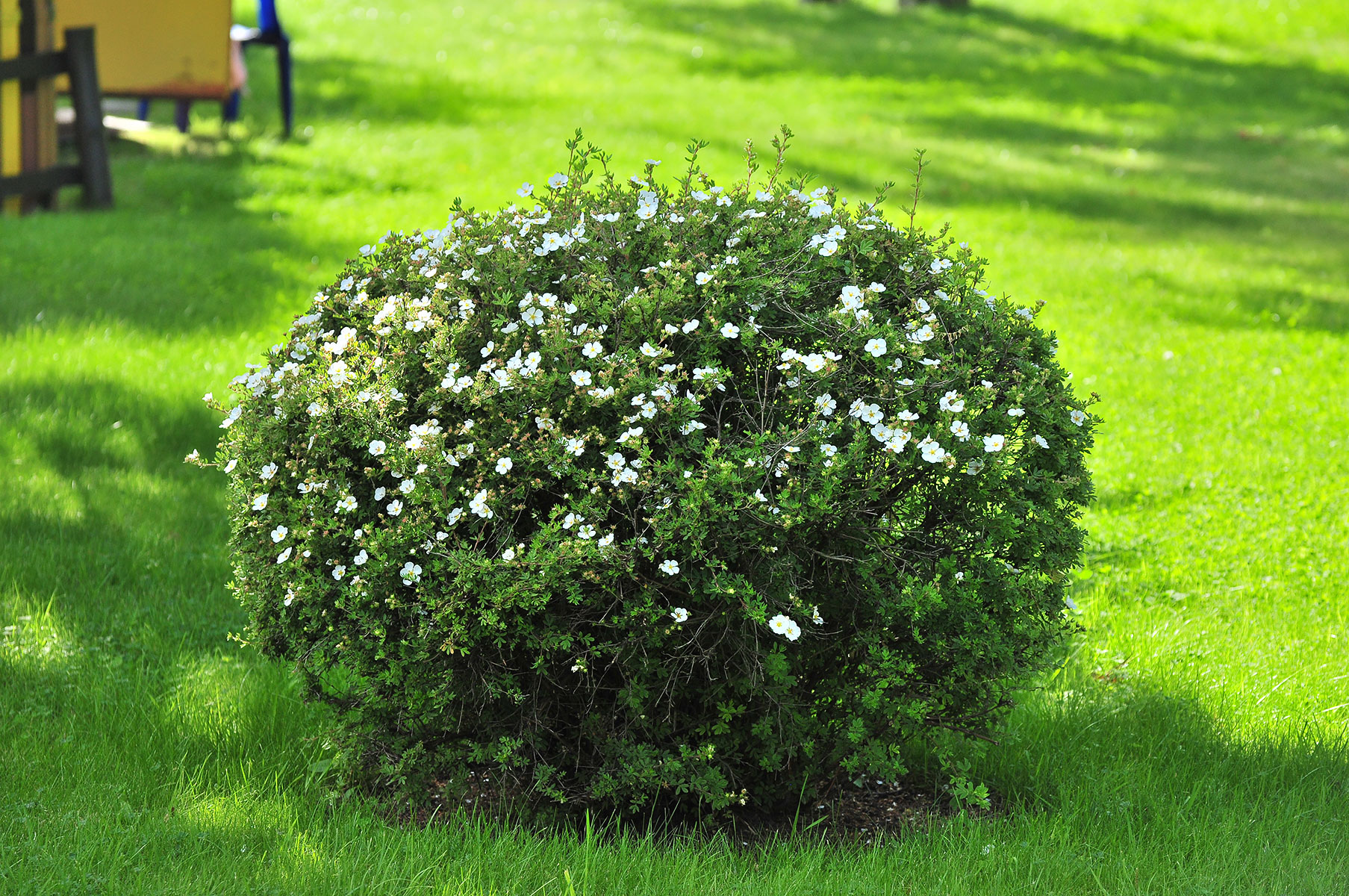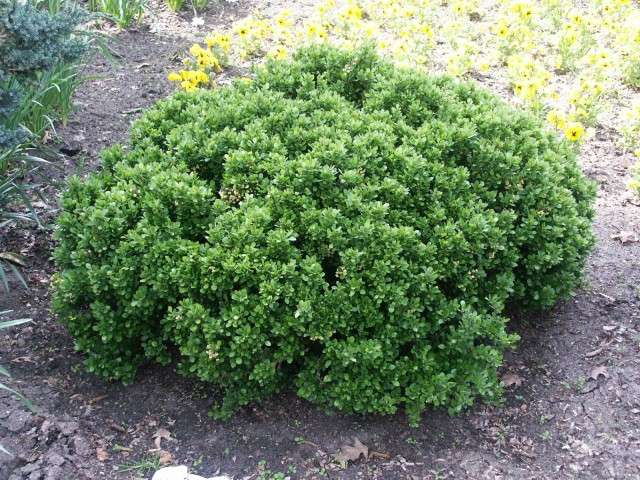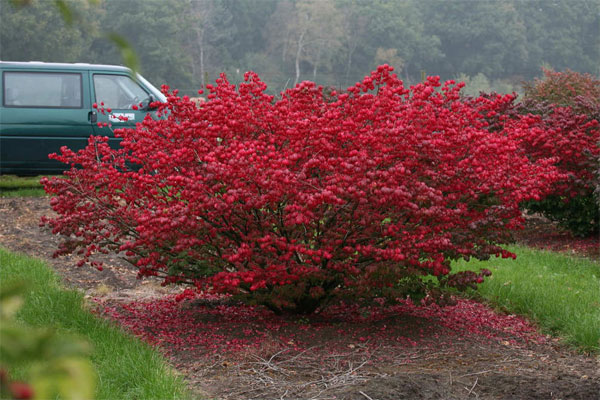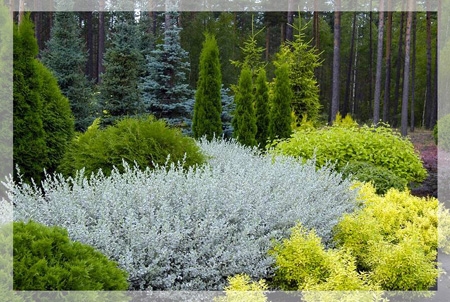Wanting to decorate their backyard, many gardeners are thinking about planting beautiful low ornamental shrubs, and in the middle lane, they must also be frost-resistant. There are a lot of shrubs, they differ in shape, color, bush height, flowering period and other parameters. Consider some species that meet the specified criteria.
Low growing ornamental shrubs
Low ornamental garden shrubs are commonly used to border borders, hedges and other areas of the garden. They can be planted "at the foot" of more tall plants, and can be used as independent units.
The most unpretentious and popular undersized shrubs:
- - tolerates drought well, but requires well-drained soil. You need to plant in shaded areas, because it burns out in direct sunlight.
- Heather is a low evergreen shrub that has a long flowering period. Its crown is formed by shoots up to 60 cm long directed strictly upwards, due to which a beautiful bush is formed. Heather grows in any soil and is unpretentious to lighting conditions.
- - a beautifully flowering low ornamental and frost-resistant shrub, which is often used as a hedge. It has thorns on the stems, and from the end of May beautiful orange-red flowers appear on its arched branches, which are then replaced by golden fruits. The shrub is not afraid of cold weather and tolerates winter well.
- Pachysandra apical is a beautiful evergreen shrub that grows quickly and loves shady places in the garden. They can decorate areas under trees, creating carpet plantings. In April, white flowers appear on the shrub, collected from spikelets.
- Potentilla shrub is a low-growing shrub that can decorate both borders and create a hedge. It blooms with bright yellow flowers that last up to 100 days. Absolutely unpretentious to growing conditions.
Creeping ornamental shrubs
The crowns of such shrubs develop in a horizontal plane, which greatly decorate the site. These include:
- Cut blackberry - spreads over 4 meters in diameter, its height is no more than 80 cm. It gives edible fruits.
- Lying juniper - a shrub up to 60 cm high, can grow up to 2 meters in diameter. Beautiful with its blue and dense needles. Unpretentious in care.
- Stephanandra incised leaf - grows quickly, braiding itself large areas. It is unpretentious in care, tolerates winters well, and when it freezes, it is capable of rapid recovery.
Frost-resistant ornamental shrubs
Living in cold regions, one must take into account such an important quality of plants as frost resistance or winter hardiness. If it is present, then the shrub will not freeze out in a fierce winter, and even if it freezes slightly, it will be able to recover.
AT recent times increasing popularity in garden design purchase ornamental shrubs. Modern selection pleases gardeners with a huge variety of hybrid forms with intricate crowns and bright leaves.
They look beautiful and are easy to care for. decorative effect are not inferior to flower beds, and the cost of their maintenance is significantly less. This attracts more and more fans. Moreover, many shrubs bloom. If you select species and varieties according to the timing of flowering, they will create a coloristic effect from early spring until late autumn. There are no such bushes that bloom in April and bloom all summer, but there are species that replace each other in seasonal decorativeness. Successfully selected specimens form a garden of continuous flowering.
Here is a list of popular types:
Shrub over 2 m. It is undemanding to growing conditions, but grows faster on rich soils. Prefers calcareous soils, but is content with neutral ones. Forsythia is photophilous, but withstands partial shade. Suffering from drafts. The main value is early flowering in April, yellow "stars" bloom when nothing is green in the garden. In summer, the shrub looks modest, but in autumn the leaves flare up with fireworks of yellow, orange, red colors.
Almost does not bloom in the shade, but is used for sheared hedges. Annual pruning with shortening of leaf shoots is desirable, otherwise flowering is completely suppressed after a few years. A popular propagation method is by bending branches to the ground. A shoot buried in autumn takes root until spring. It is better to plant and propagate forsythia in the fall.
Three-lobed almond - Louisiana three-lobed
A large shrub growing over 3 m, with a disorderly sprawling crown. AT decorative design the forms "Captivity" and "Kyiv" are popular. Almonds are distinguished by early spring flowering in early May. double flowers pink, light red or raspberry color last 2-3 weeks. Most of the summer it looks unattractive, and in the fall it does not differ in showiness.
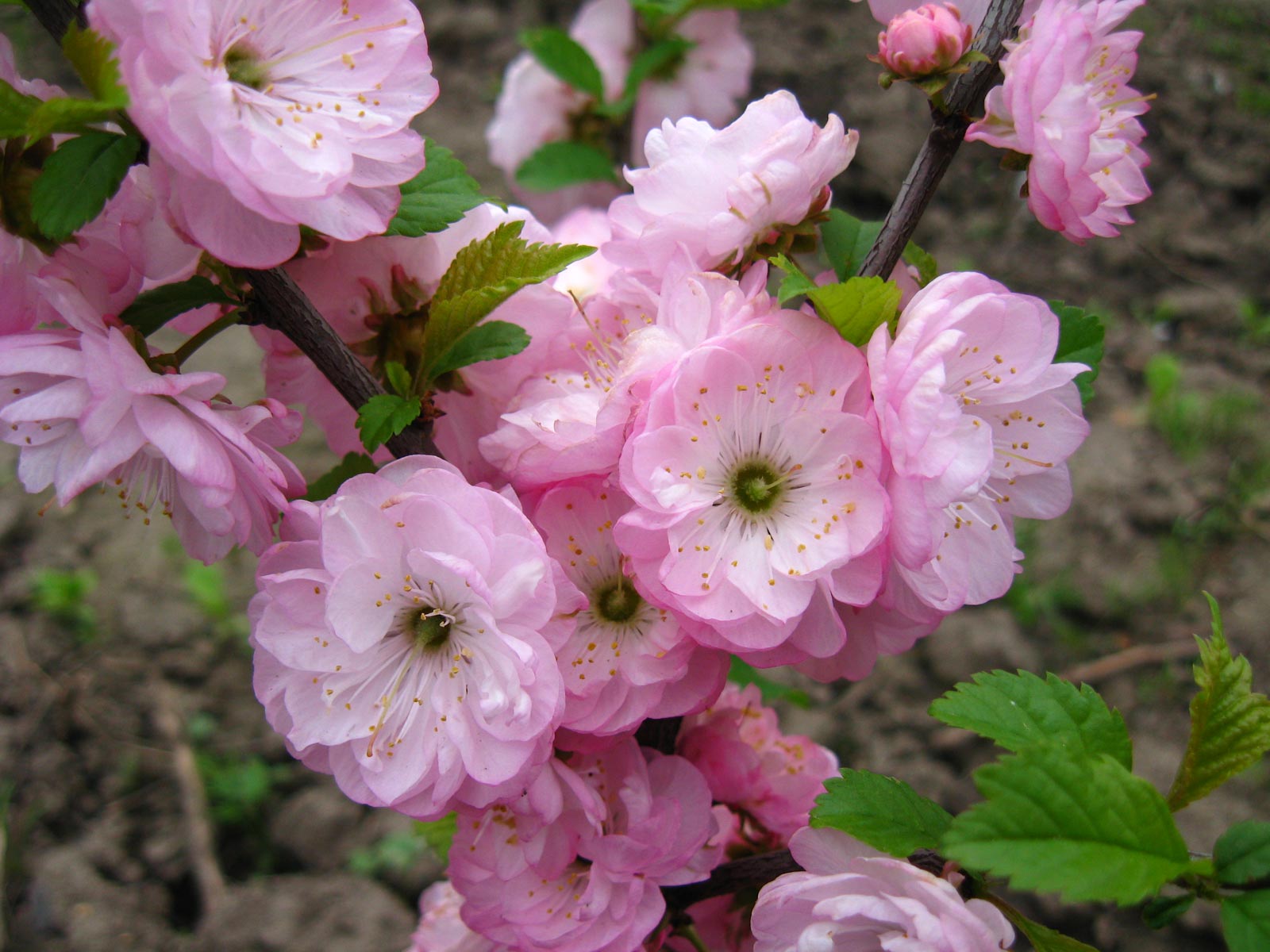
One of the qualities in favor of Louisiana is high winter hardiness. It prefers rich fertile soil, although it survives on any. It treats watering with restraint, even successfully tolerates a short-term drought. But the duration of flowering directly depends on moisture, the more water, the longer you can admire the beautiful "pink foam".
Chaenomeles - Japanese quince
Long-lived shrub good care reaches the age of 80. The average height is 1.5 m, it grows up to 3 m. The dense crown consists of prickly shoots. Scarlet-red flowers appear in May. Prefers rich soils, but tolerates any. Loves light, but tolerates partial shade. Differs in steady frost resistance.
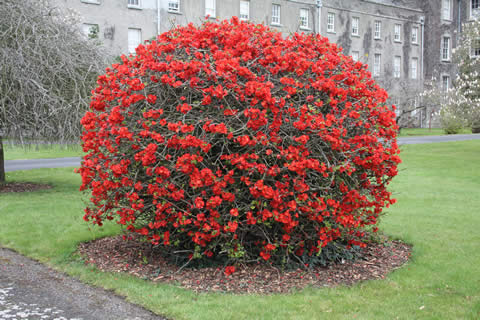
In culture, varieties with different colors are popular:
- yellow in a pink border - "Papel";
- salmon-orange Gaillardi;
- pink - "Malardi"
The rose is called the queen of the garden, and the lilac is the queen of May. It is interesting to note that a huge number of varieties belong to the same species Common lilac, almost always propagated only by grafting. Root growth, most likely will not give the desired variety when flowering. As a result of selection, there were so many of them that botanists divided them into 8 groups according to the color of the flowers. The color range ranges from snow white to deep purple. It blooms in May, on average 2 - 3 weeks.
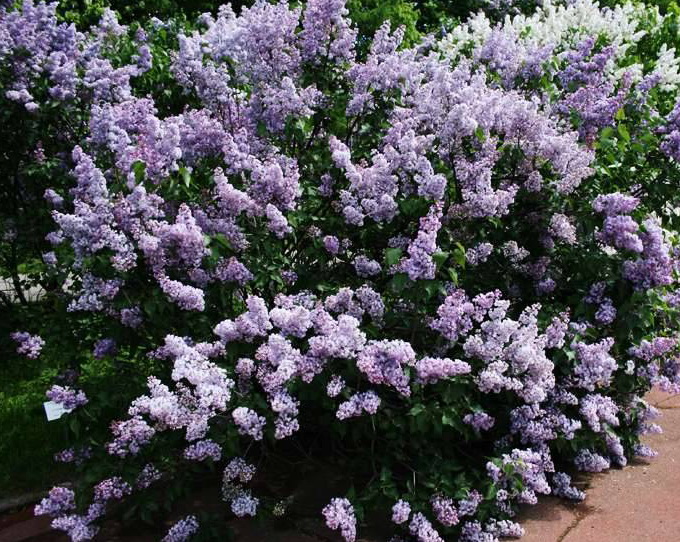
In care unpretentious. It is favorable to fertile soils of neutral reaction. Prefers comfortable, wind-protected places. Needs annual pruning. Gardeners often form it in the form of a tree.
Spiraea Van Gutta
This non-capricious beauty is popularly called the bride. In May, white flowers cover it with an even layer. At this time, the bush is visible from everywhere. This "outfit" lasts up to a month. At other times, it looks neat and compact, despite its considerable height - over 2 m. In a sunny place and well-drained soils, it feels better than in the shade. Extremely cold hardy.
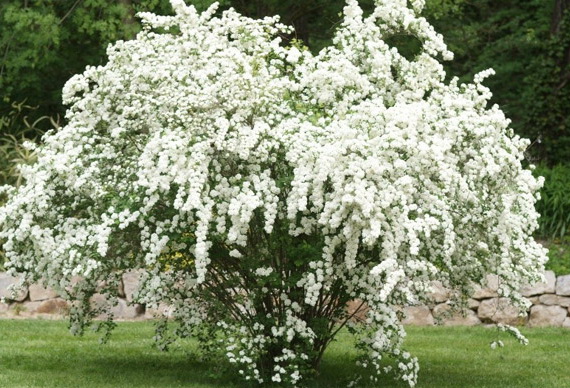
Use to form free-growing and sheared hedges. Among the numerous relatives, divided into 4 flowering groups, Spiraea Van - Gutta is the most famous and popular among gardeners.
Tall shrub 2.5 m blooms in late May, early June 2 - 3 weeks. White "stars" are collected in inflorescences 10 - 15 cm. Does not like the scorching sun, prefers partial shade. It is quite winter-hardy, in cold winters the shoots freeze to the ground, but in spring they recover from the root. Does not tolerate drafts, young plants are especially affected.
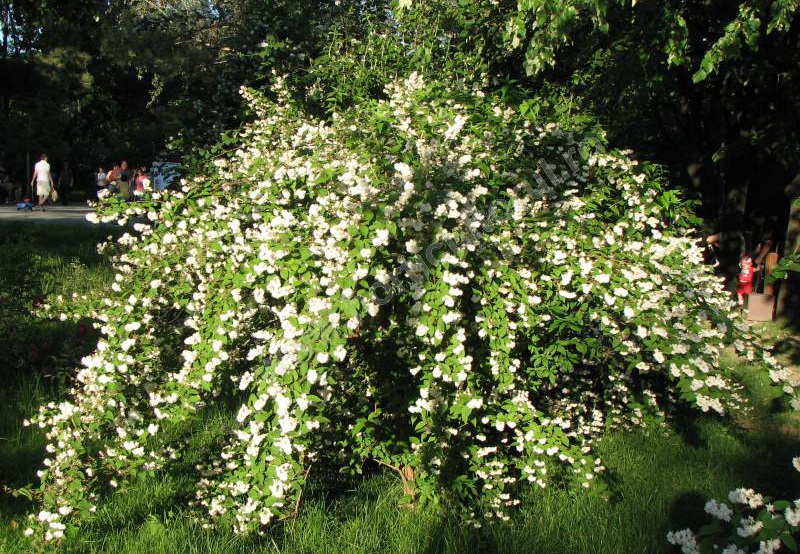
Breeding varieties are presented:
- Candidissima;
— Rjseo-plena;
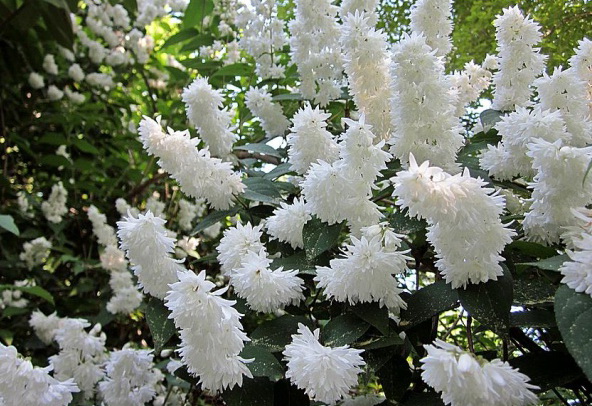
Spectacular decorative effect and rare unpretentiousness made Barberry a favorite of gardeners. Due to the speed of growth, compactness of the crown, flowering and ripening of edible fruits, it is considered an ideal plant. Breeders have bred many forms with different heights and leaf colors. If the species Barberry is not extremely picky about growing conditions, then the “colored” varieties require a lot of light, otherwise yellow, purple or speckled leaves turn green.
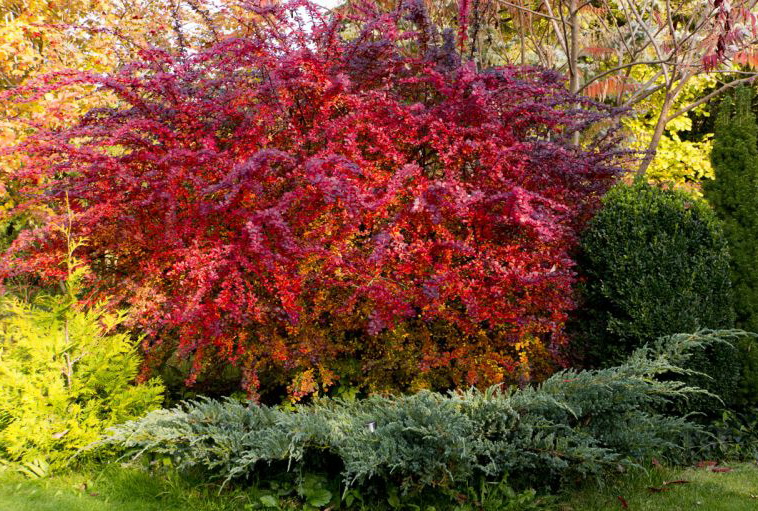
At the end of May, beginning of June, spectacular bright colors appear on the bush. yellow flowers that last three to four weeks. By autumn, red berries ripen, which are used in cooking. In winter, they decorate the garden until they are pecked by birds.
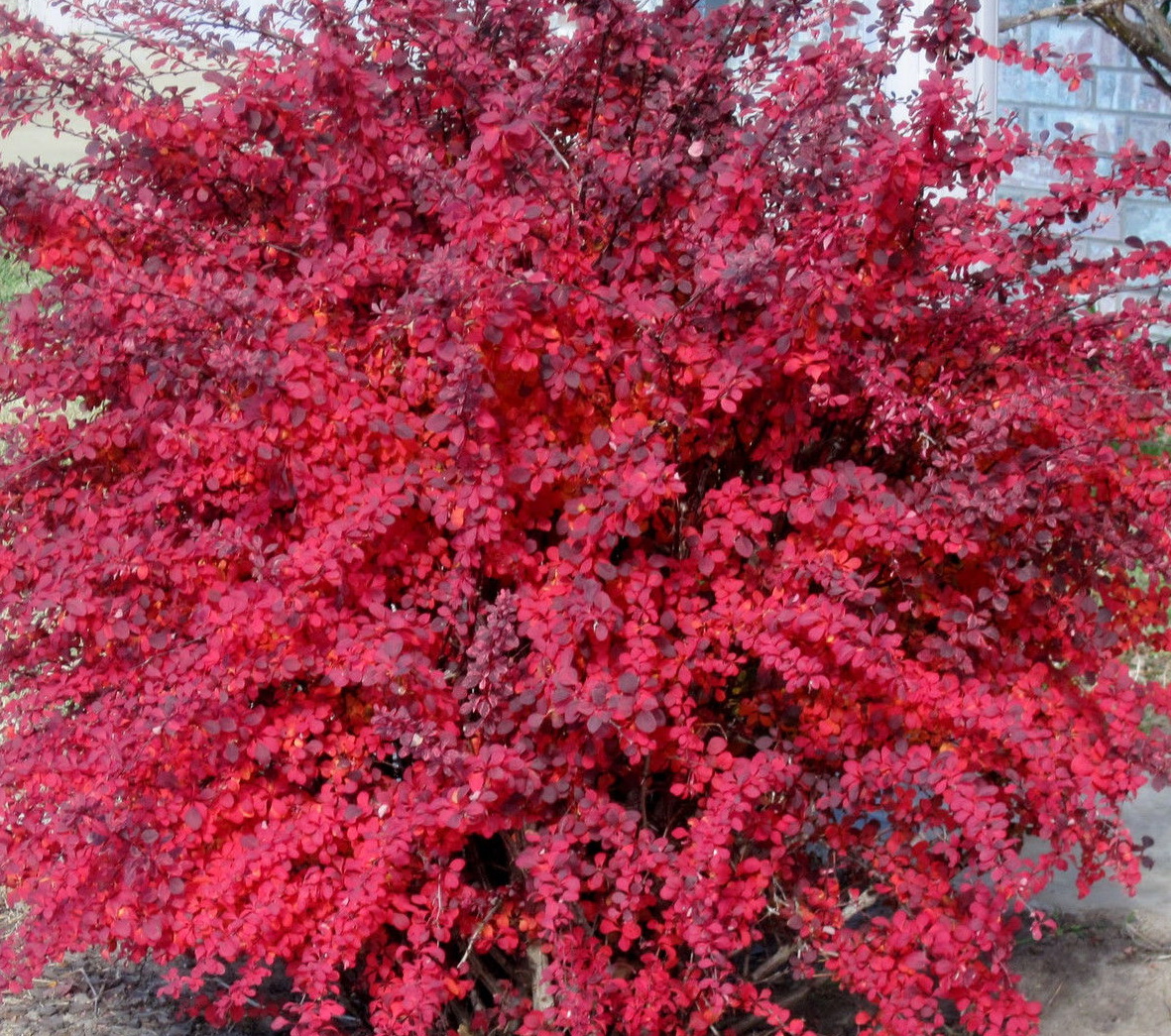
In the people it is often called Jasmine for the deep perfumery aroma of flowers. Shrub 3 m high. Numerous shoots grow densely from the ground. For this reason, it needs annual thinning, which favorably affects the abundance of flowering in late May and early June.
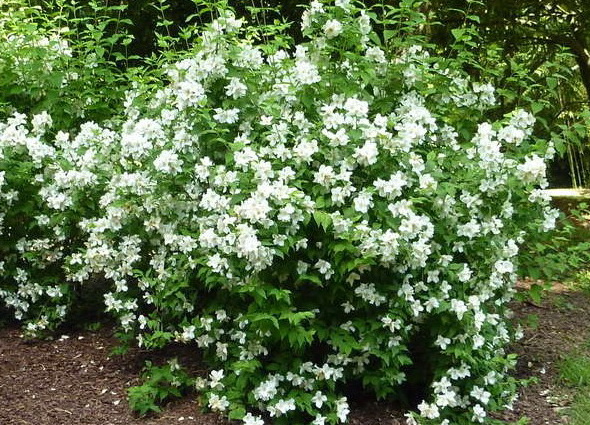
It is undemanding to conditions, grows well both in the sun and in the shade. Lack of light affects the quality and quantity of flowers.
It tolerates winter and frosts down to minus 25 0 well. If it still freezes, in spring young shoots grow up to 1.5 m and bloom in the same year.
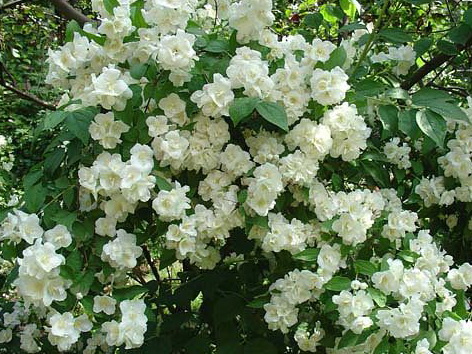
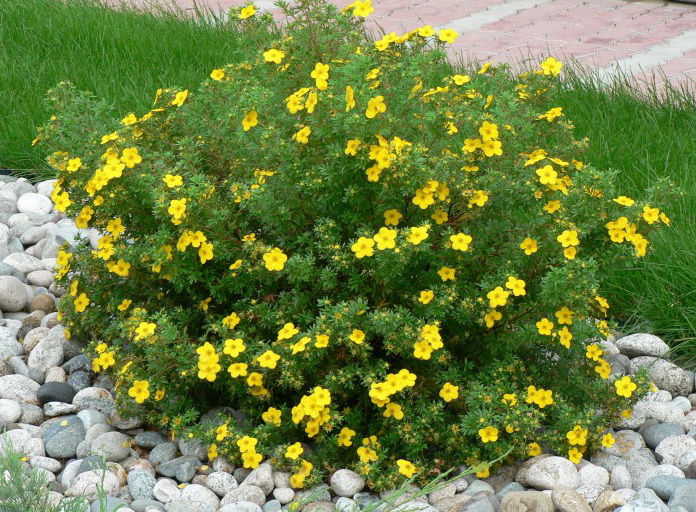
Potentilla got its name for the shape of the leaves, people say about it: "crow's feet". Valued for beautiful small dense leaves and long-term flowering. In sunny places, bright yellow flowers appear in June and change continuously until September. Almost never blooms in shade. It is used as a solitary plant and in hedges, it cuts well. It has many varieties of different colors, but they are inferior in the duration of flowering to the original species.
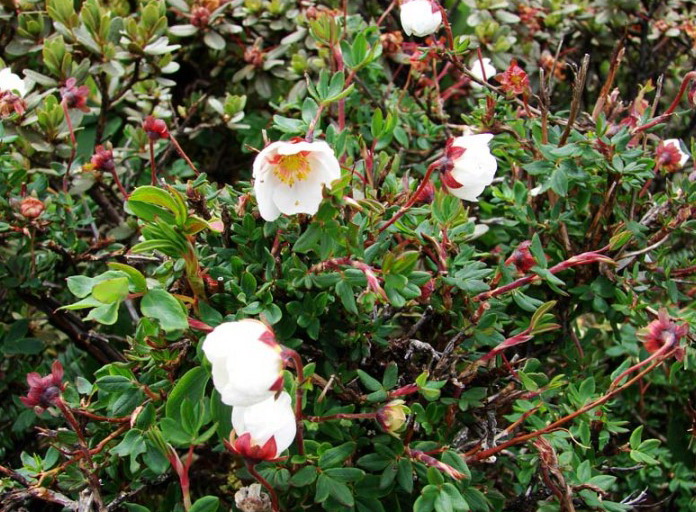
In care, it is not capricious, but without attention it runs wild, grows randomly and blooms worse.
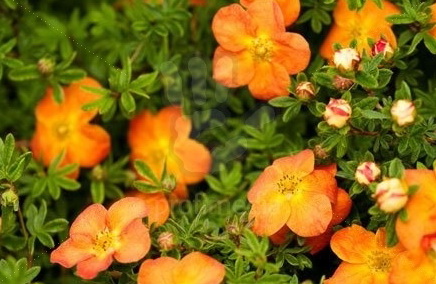
In dark, damp places it feels better than in the open, it does not tolerate drought. Winter-hardy and frost-resistant.
A shrub that blooms the very last in the garden - in August. The plant is thermophilic and often freezes over in winter, so in late autumn it is cut and spud like roses.
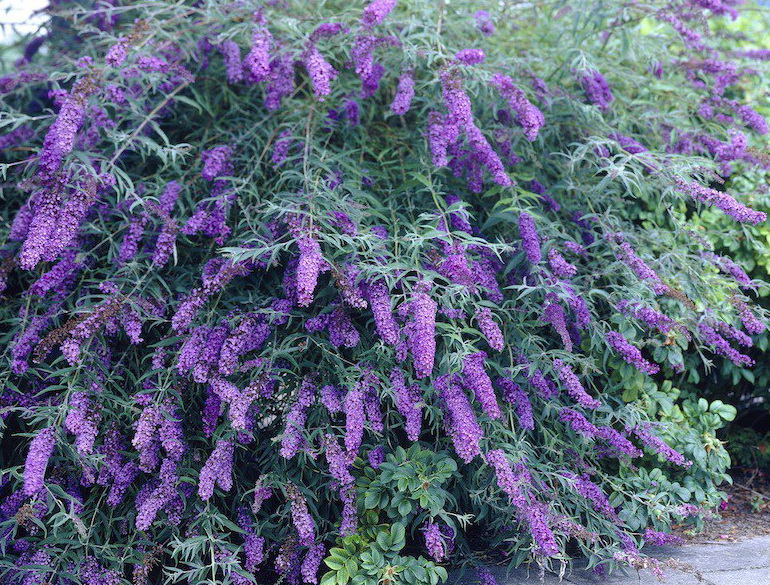
Pinkish-lilac flowers are collected in long brushes, for this quality it is called autumn lilac. Buddleia emits a sweet fragrance that attracts bees and butterflies. This bright tandem lasts a month and a half.
Popular varieties with different flower colors:
- Royal Red - with lilac-red;
- Alba - white;
- Orchid Beauty - pale lilac,
- Empire Blue - blue-violet;
— Black Knight - dark purple;
— Fascinating - pink,
— White Profusion - white-pink.
The necessary conditions:
- good lighting;
- a place protected from the wind;
— fertile soil;
- abundant watering. And Budleya will delight with flowers until late autumn.
This small assortment of hardy shrubs will fill the garden with flowers from April to October.
Planting garlic before winter is a responsible event, here you need to choose the right one planting material, correctly determine the landing time, know the subtleties and rules, nuances and features. Let me start with such nuances. Garlic has two different forms: one is referred to as non-arrowing, the second is arrowing. What is an arrow? The simplest is the peduncle. The arrow is formed only by winter garlic, that is, the one that we sow in autumn.
Transplanting sooner or later is necessary for all indoor plants. But in the case of indoor large-sized, it is not carried out as long as possible, since this is not an easy task. And rarely, what adult plants need an annual transplant. In years when transplantation is not carried out, it is recommended to perform a mandatory procedure - a partial replacement of the soil. The topsoil is replaced both for hygiene purposes and to maintain the normal state of the substrate.
Winter pickled cucumbers, crunchy, jarred with garlic, onion and chili are another easy way to prepare savory vegetables for winter. There are many recipes for pickles and marinades, even a lot. This recipe has a twist that is intended for spicy lovers: add a pinch of cayenne pepper to the marinade, and a green chili pod to the vegetables. Such cucumbers, ladies forgive me, will appeal to the strong half of humanity - an amazing cold appetizer.
The vast majority of gardeners, especially summer residents, after the end of the berry picking season, forget about their shrubs until next spring and, at best, feed them after the snow melts with a handful of nitroammophos or weed them, removing the rapidly growing couch grass. This fate befell the black currant. Although outwardly the culture seems to be a healthy and strong shrub, it also requires care and attention. And especially in the autumn, when there is a long winter ahead.
Hydrangeas - shrubs are not only fashionable, but also irreplaceable. They are used both in urban landscaping and in private gardens, paying tribute to the bright foliage, pastel colors of the inflorescence caps and stable decorative effect. Most often, hydrangeas are planted in groups or singly, mixing with other bushes and trees. Meanwhile, perennials will also be able to keep these garden princesses company, with the help of which you can create colorful, stylish and expressive combinations.
Lentil cutlets with chanterelles is a delicious, original hot dish that can be served for dinner with a side dish of mashed potatoes and a thick white sauce. If you want to surprise your guests and family, cook these tender meatballs. You can replace chanterelles with champignons, because it is not every month that you will meet in the forest or on the market exactly “forest gold”. I cooked cutlets from Canadian green lentils, they are cooked in about half an hour. Regular lentils need to be soaked in advance.
In the current season, alas, there is no record apple harvest: the rainy and rather cool summer, which looked like a mixture of autumn and spring, interfered. But still, there is a harvest, it is tangible, and if we do not want the harvested apples to spoil in a couple of weeks, they must be properly stored. They say that with proper storage, an apple can lie for several years, retaining its varietal qualities and properties, but why should we wait so long to taste it?!
One of the most original types of indoor blehnum ferns is rightfully considered one of the most capricious. Its thermophilicity and humidity requirements have turned this relic plant into a real legend. Blekhnum, or derbyanka in the room - the fern is not for everyone, but it is surprisingly beautiful. Rather large sizes and remotely reminiscent of palm leaves, fronds will easily outshine any other decorative leafy plant in your interior.
Pancakes from zucchini with cheese and garlic - tasty dish worthy of a Sunday breakfast, especially in harvest season. Pancakes are a useful thing, you can’t prepare them for the future, but you can completely eliminate part of the crop with benefit. For a family of three, one medium-sized vegetable weighing up to 1 kilogram minus cleaning is used. From this amount, you get an impressive appetizing slide of pancakes, which will famously leave with sour cream while watching the Sunday morning show.
Mixed ridges and narrow long flower beds along the paths and walls are in fashion today. And although this is the most colorful, it is not the only design option for colorful plant frames of various functional purposes. Sometimes it is not advisable to break even the smallest ridge about half a meter wide; the design requires greater rigor and “subtlety” of the plant line. A narrow and neat border of one plant is the most obvious, but the only way out.
Now is the very beginning of autumn, the whole crop has not even been harvested from the site yet. But you may not believe that in order to ensure the harvest of the next season, the vacated soil, for future beds, is already time to start preparing. And this is not a joke at all: you need to prepare this soil correctly so as not to be disappointed in the next year's harvest. How to prepare the beds, how to properly dig and fertilize the most common vegetable crops right now, we will tell you today.
Pickled cucumbers in circles with citric acid are garnish cucumbers, the cooking principle of which I somehow spied on in one TV show. They showed a large factory where cucumbers are pickled for hamburgers. These are really excellent side dishes, which are indispensable in cases of emergency, when there is no time to cook dinner, but you need to feed your family. On a plate with mashed potatoes and sausages, he put a hill of cucumbers with onions - and it's already delicious!
Proper nutrition for indoor plants- one of the factors of their normal development. Fertilizers are often misunderstood as just a flowering or growth aid, but their significance is much more important. Plants obtain substances from the soil and air. But in a limited amount of substrate, they depend on whether top dressing is carried out correctly and what fertilizers are used. For pets, both macro- and microelements are equally important.
Homemade tomato juice, in the recipe of which a blender is used, is simple, tasty and within the power of any housewife. I don't use a juicer. Frankly, it's just a pity for the place in the kitchen. This kitchen gadget is needed only a couple of months a year, if you are not a fan of freshly squeezed drinks, and it will take a shelf in the locker firmly and for a long time. An ordinary blender, and in the old days a simple meat grinder and a sieve, solve the cooking problem tomato juice at home.
Potash fertilizers, along with phosphorus and nitrogen fertilizers, are very important for plants, since potassium is a significant element for them, one of the three pillars on which the entire life potential of any organism rests, so the application of potash fertilizers should by no means be ignored, especially since there are many fertilizers that contain potassium, and you can choose the most suitable for the type of soil of your site and the plants growing on it.
Colorful symbols of summer, quivering, delicate, and at the same time so hardy, decorative poppies, leave no one indifferent. The inimitable colors and details of the structure of these amazing flowers are an invariable decoration of any garden in the summer. But the cultivation of decorative poppies is not a completely standard task, although not a difficult one. Poppies are propagated by seeds, and the choice of methods and methods of sowing allows everyone to find their own ideal option.
Each gardener tries to plant their garden as best as possible, but not every plant will adapt to low temperatures, so here is a list ornamental flowering frost-resistant low beautiful shrubs.
To begin with, a few words about the scope of the use of such plants. Firstly, this catalog will suit you if you decide to design a small garden or simply do not want to see shrubs that grow to a three-meter height. Secondly, with the help of low flowering shrubs you can plant entire strips, entire hedges. Most shrubs can be pruned if they start to grow too much. .
Note that many dwarf shrubs are special varieties of plants (two-meter white turf, Canadian dwarf turf). Therefore, when buying a bush for your garden, make sure that they are undersized. Thanks to low-growing varieties, your garden will look very representative, like an ordinary garden, because there will be the same number of separately growing bushes, and they do not take up much space.
Catalog of ornamental flowering frost-resistant low beautiful shrubs - 15 pieces with photo
Let's see 15 shrubs with photos and names that fit the following conditions: undersized, frost-resistant, beautiful.
|
Kuril tea or shrubby cinquefoil - decorative frost-resistant low and beautiful shrub, not afraid even of severe frosts of most of Russia. It blooms for two months - July and August, and in September the bush bears fruits from which tea is made. It will be interesting to you that Kuril tea lends itself well to shearing: the flowering of the shrub will even increase. And if you need a low bush, you can’t refuse a haircut.
|
|
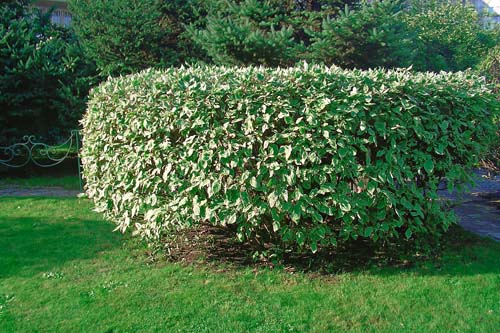 |
White Derain is a medium-sized shrub. Derain Canadian - creeping shrub, reaches a height of 30 cm. Canadian derain has amazing frost resistance, zone 2, can withstand temperatures up to -45 degrees. |
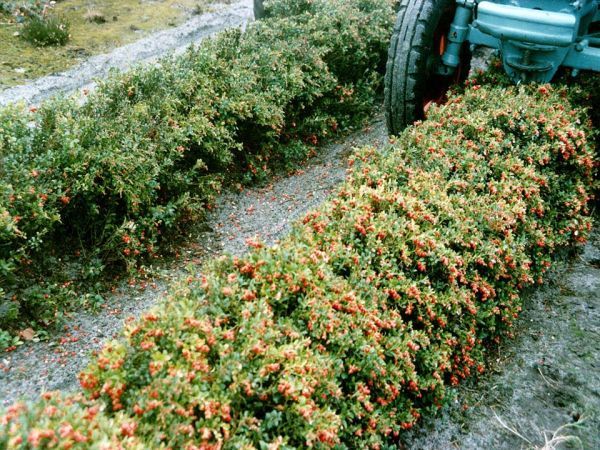 |
Common lingonberry - decorative dwarf hardy beautiful shrub (30 cm wide and high), the plant is so popular that it is grown in nurseries. Frost resistance - zone 1, withstands frosts up to 50 degrees! |
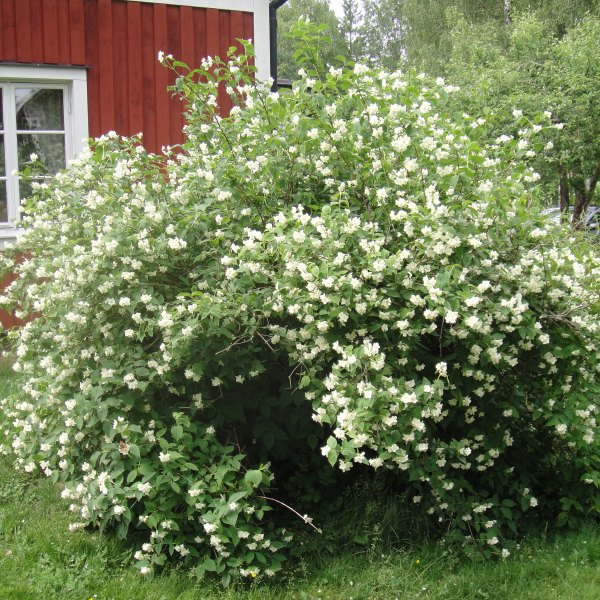
|
FROMtenderberry- a frost-resistant beautiful low shrub that blooms all summer (June and July). Pleases passers-by with white flowers, and at the beginning of autumn, white inedible berries appear on the branches of the plant (causes irritation like on the skin, and indigestion, a lot side effects, warn the children), which, like beads, adorn the bush all winter. In warm autumn conditions, the snowberry can bloom a second time. Not very low shrub, reaches a height of two meters, like any bush, you can cut it. |
|
|
Barberry boxwood - decorative low blooming with yellow inflorescences, frost-resistant shrub. Frost resistance zone 5 (up to -30 degrees). The plant is beautiful low - usually 30 cm, it is formed up to a maximum of 50 cm. |
|
|
Low, blooming with small flowers ornamental shrub euonymus- a frost-resistant plant that can withstand frosts down to -25 degrees (zone 6). Height reaches 60 cm, girth 80 cm. |
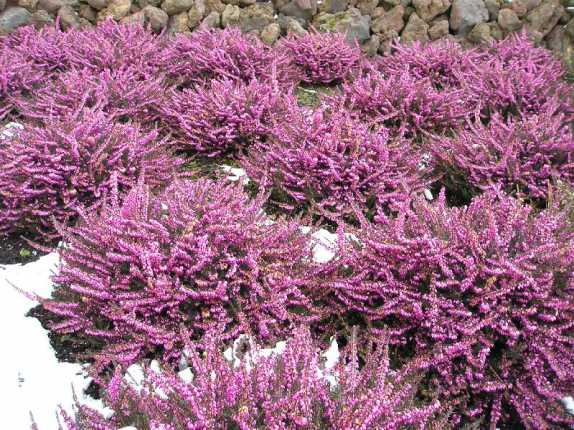 |
Herbal Erica - very graceful, undersized, frost-resistant (up to -25 degrees, zone 6) |
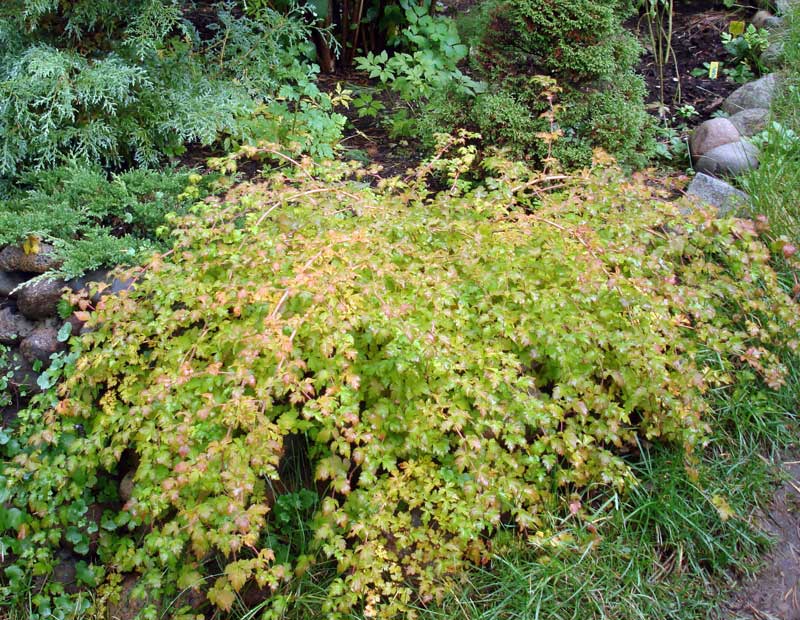 |
Stefanandra notched leaf is a low, beautiful shrub for the 5th winter hardiness zone (up to -30 degrees). The height of the shrub is 50 cm, in girth it is significant up to 150 cm, spreading openwork. |
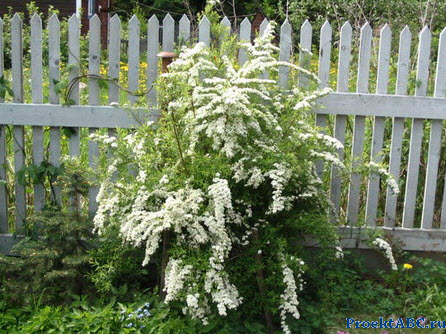 |
Japanese spirea is a low shrub, 40 cm tall and 40 cm wide. 4 frost resistance zone, up to -35 degrees. Blooms in June, July; flowering time 45 days. |
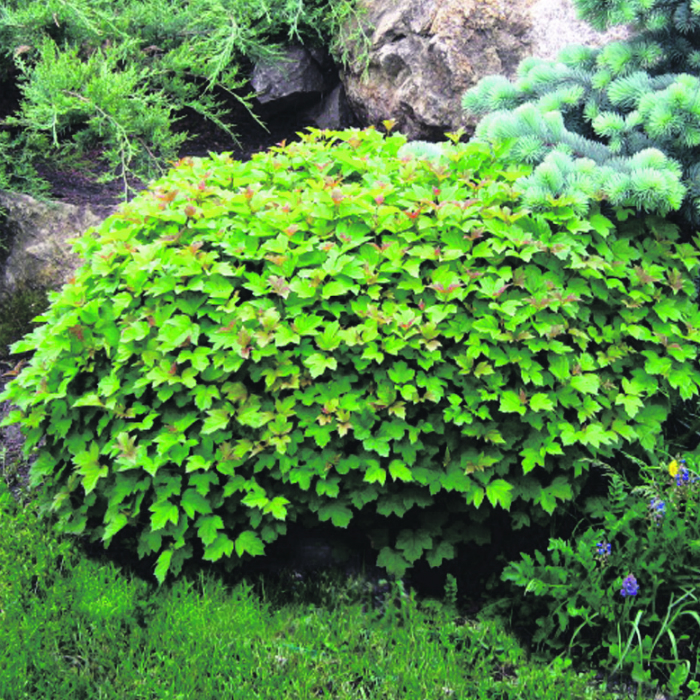 |
Dwarf decorative viburnum, varieties Nanum, grows up to 50 cm high. 4 zone, up to -35 degrees. Blooms in May-June, smells good |
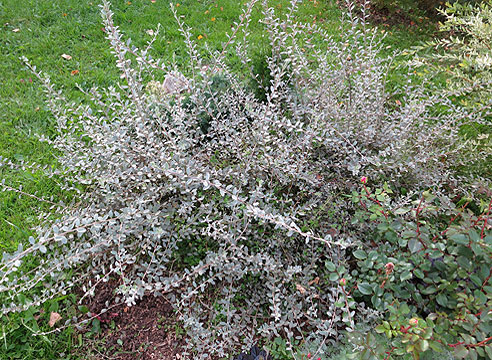 |
Creeping willow is a low beautiful shrub (height up to 50 cm, width up to 100 cm) with silvery leaves, it does not bloom, but its very appearance will form an advantageous landscape design. Shrub from the 5th zone, winters at temperatures of -30 degrees.
|
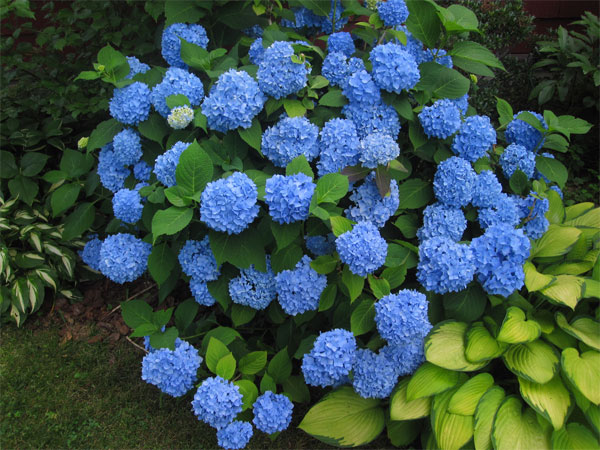 |
Hydrangea - it is impossible to pass by this bright, luxuriantly flowering beautiful bush. The bush is distinguished by voluminous inflorescences in the shape of a ball. The variety of color palette delights, the color of the inflorescences depends on the acidity of the soil. At high level acidity, inflorescences are brighter. Flowering time is August and September. Hydrangea can be safely planted in partial shade, it is not afraid of frost up to -20. This shrub does not grow well in limestone and dry soil. |


